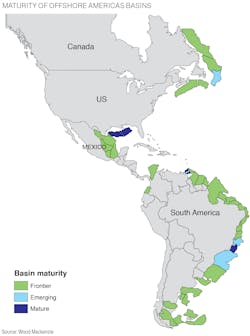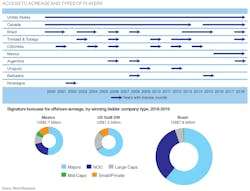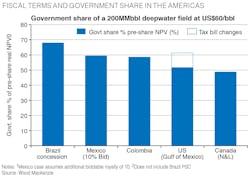E&P growth opportunities abound in deepwater Americas
Erik Oswald, VP Americas, ExxonMobil Exploration
Cindy Yeilding, Senior VP, BP Americas
Carlos Portela, President, Ecopetrol America
Tim Duncan, CEO, Talos Energy
Liz Schwarze, VP Global Exploration, Chevron
Chris Golden, Senior VP, Equinor
Julie Wilson, Director, Wood Mackenzie
Sandeep Khurana, Head of Advisory, Granherne
The deepwater basins of the Americas have been among the most active and successful with discovered resources to date of over 100 Bboe. Some of the world’s most prolific hydrocarbon basins are located along the Americas margins. Considerable undiscovered potential remains, and prospects can be multi-billion barrels of oil in size. Of particular focus here are the deepwater hot spots in East Coast Canada, Gulf of Mexico, the Equatorial and Atlantic Margins, and Colombia.
Global deepwater investment suffered severe cuts following the oil price crash of 2014. Exploration spend was slashed, the number of new projects receiving final investment decision (FID) fell dramatically, and production declined in many places. Shorter-cycle projects with lower capital commitments were favored. In particular, North American shale plays became the darling of the industry and the market.
The deepwater sector has been making a comeback since the beginning of 2017, especially in the Americas. In this region, large tracts of acreage have been licensed, capex is on the rise and production is set to increase. Deepwater offers a strong alternative investment profile to shale that can be counter-cyclic. During short-term price fluctuations, onstream fields continue to produce at stable rates with relatively small operating and maintenance costs.
The gross domestic product of countries in the Americas has been steadily growing over the years and these economies are forecast to continue growing. Achieving energy security is challenging and the best way to do it is through increased levels of exploration. It can be risky to depend on outside suppliers that are exposed to geopolitical risk. Disruptions in supply can threaten the development of the country and the entire region. It is, therefore, wise to incentivize exploration by creating the right business environment for investment.
The Americas benefit from attractive geology and robust petroleum systems. There are multiple play types of different maturities, which allow an operator to take a portfolio approach within the region. But historically, the high variability in approach by governments to the sector has led to wide variations in the pace and success of activity.
Some countries in Latin America have no current production. In a few, production is growing; while in others, it is declining. There is often an urgent need for countries and their NOCs to add new resources and reserves. For example, Colombia’s entire reserves-to-production (R/P) ratio is just seven years. The largest potential often lies in underexplored frontier basins. In Colombia, for example, the future of conventional oil lies in the Caribbean offshore basin, a frontier area yet to be widely explored. Countries need to attract new investors, explorers, and projects. To achieve this, governments need to articulate a competitive regulatory and fiscal framework, with clear rules and long-term stability.The deepwater industry is in its infancy in several countries in the region, such as Colombia, Guyana, and Argentina. This creates opportunities stemming from a promising geology, with many plays still to be tested. Alongside that, however, are diverse risks, including subsurface risk (presence and phase of hydrocarbons, reservoir deliverability), lack of infrastructure in offshore basins, intermittent access and sometimes a slow socio-environmental permitting process. These risks can make a country with a frontier offshore sector less competitive for investment when compared with well-established oil countries such as Brazil, Mexico, or the United States.
A vibrant offshore industry across the deepwater basins of the Americas is a result of a variety of factors such as acreage access, fiscal terms, regulatory environment, people and players, technology and supply chain. The acreage access, fiscal terms and regulatory environment attract and retain industry benefits for all. The availability of highly qualified people and the mix of players are unique to the region and serve to promote both collaboration and competition. Technology and an efficient supply chain sustain value creation through fluctuating commodity prices by providing ways to contain costs using innovation, synergies in the region, and avenues for gas commercialization. These elements underpin the value of Americas deepwater oil and gas and are the focus of this article. We address the variations across different basins and consider the implications for the industry and the challenges that lie ahead.
COMPETING FOR INVESTMENT
Countries in the Americas must compete on a global basis to attract investment. The first step required to attract and retain industry is access to promising acreage by capable, responsible operators. None of the benefits (including economic, social, poverty amelioration, improved standards of living, etc.) from endowed resources can be realized without access. Countries that consistently provide opportunities for industry to acquire and explore have benefited with significant wealth created from the oil and gas sector. Consistent access creates a positive feedback loop where industry investment leads to creation of infrastructure, technological centers, a skilled workforce, and economic growth. Benefits are cumulative. Industry can then pull on these developed resources to further explore the deepwater and take advantage of established supply chains to lower costs. Sustained access sets the pace of offshore exploration and allows industry to continue large investments in any one country.
The Americas have had a mixed history of sustained access to high quality deepwater exploration acreage. The US Gulf of Mexico and Canada have a long record of regular tender/license rounds, which has led to more mature infrastructure, supply chains and targeted technology development in addition to significant income generation for the countries.
The recent tender rounds in Brazil presalt (2017-2018) and Mexico (2015-2018) after long hiatuses of no access have substantially increased investment in the oil and gas sector with initial well results from those tenders expected in the first half of 2019. Access remains challenged in parts of the US, French Guiana, and Venezuela due to geopolitical factors and/or government environmental concerns. Countries that have offered no or limited offshore acreage previously are beginning to stage tender rounds, such as Argentina, Guatemala and Barbados. Most countries in the Americas, in contrast to other regions, use the license/tender round model of access for exploration acreage offerings. The advantage of this model for all parties is a predictable schedule of acreage offerings that facilitates resource planning, a transparent process of contract awards that supports anticorruption imperatives and increased competition from a wider range of industry that generates bonuses commensurate with market value.When significant breaks in access occur, countries lose a significant income-generating sector. One example of a pause in exploration tenders and loss of potential revenue is the Brazil presalt Santos basin from 2008 to 2013 and from 2013 to 2017. After the discovery of the super-giant Tupi field, the government of Brazil halted new presalt exploration, created the presalt polygon area, with the associated requirement of Petrobras as sole operator, and established the PSC fiscal structure. Five years after the initial break in tender rounds, PSC1 was held in November 2013 with one asset, the discovered undeveloped Libra field, offered in the round. After PSC1, no further presalt rounds occurred until October 2017 when both the PSC2 unitization and PSC3 exploration rounds took place and then again in June and September 2018 with the PSC4 and PSC5 rounds, respectively. Industry responded strongly to the PSC rounds with around $5 billion in bonus committed, reflecting the pent-up energy for access to numerous presalt multi-billion-barrel prospects. Over this roughly 10-year period, with the exception of PSC1, industry was unable to bid for some of the highest quality deepwater opportunities in the world. The ANP (Brazil’s oil regulator) called the postponement of the presalt exploration rounds during this period “the greatest opportunity lost in a generation.” The ANP estimated that it resulted in a deferral of revenue of around $350 billion in the form of lost royalties, signature bonus, income tax, R&D, and capital investments.
The break in Brazil presalt tenders led to dramatic decreases in exploration and development wells drilled. However, presalt production strongly increased because it was based on the assets that were already under contract at the time of the tender round suspension.
There are parallels and differences in the Mexican sector of the Gulf of Mexico. Mexico has had to build its contractual and regulatory framework, licensing process, and fiscal system almost from scratch since the December 2013 Reforma, the re-opening of the oil and gas sector to international investment. The different branches of government and regulatory authorities have so far been highly motivated and pragmatic. Their goal is to progress the Reforma quickly to spur activity and growth. As a result, the scale and speed of the opening is unprecedented.
Governments are the ultimate steward of their hydrocarbon resources and the terms and frequency of access is their prerogative. Industry’s imperative is to make a thoughtful case for change that is based on a robust and responsible exploration plan that also considers the strategic, political, environmental and economic rationalizations of countries. All of these factors must be balanced with all the positive outcomes of wealth generation.
Appropriate fiscal regimes
The high-quality reservoirs and world-class hydrocarbon basins in the Americas initially attracted industry to explore and invest, but equally as important are fiscal terms that are both attractive and appropriate for the quality and the risk of the resources offered. Value from a country’s hydrocarbon resources is maximized when contracts provide structure and terms that are equitable and fair to both the government and the investing companies, and are competitive globally. High-risk frontier exploration may require moderate government take with low entry costs or incentives for industry investment to de-risk plays such as in offshore Argentina or the Canadian Arctic. In contrast, exploration investment in proven, world-class hydrocarbon provinces with high per well productivity can handle higher government take or signature bonus levels for the same return because of lower subsurface risk, such as the Brazil presalt play.
That being said, new plays in known provinces may still carry a significant amount of subsurface and development risk. If this higher risk level is acknowledged in the terms, new play tests in “proven” basins are more likely to move ahead. If there is no allowance made in the terms, cost can quickly become a deterrent for new play tests.
Governments can promote a stable and sustainable business environment by ensuring a high degree of certainty in contract and fiscal terms, legal frameworks and rule of law. One opportunity is to provide durable contracts, which can be especially important to industry given the high level of investment required in oil and gas developments and the long duration of these projects. Project uncertainty, such as exposure to low- and high-side outcomes, is unavoidable in exploration and development; however, contracts can be designed to take this into account when conditions change relative to the investment case basis. Maintaining balance between government take and industry share of profit can be addressed through contracts that contain moderate progressivity with respect to project profitability. This allows for government take to increase in the case of low unit costs or higher prices, and to decrease in the case of high unit costs or lower prices. Industry can develop the marginal barrel in low-side outcomes because government take is lower and ultimately more of the overall resource is developed – benefiting the resource holder.
An example of an Americas fiscal framework where this concept is illustrated is Brazil’s PSC regime in which the biddable parameter is the government share of profit oil at an oil price of $60/bbl and a well rate of less than or equal to 12 kb/d. Progressivity is introduced into the system by varying the government share of the profit oil from the base bid with both the actual prices and the well rates realized (which is a proxy for costs). The government reaps a higher share of revenues in high price and/or high productivity scenarios and a lower share of revenues for low price and/or low productivity cases. It should be noted that a PSC framework is not required to build in progressivity. Concession contracts can also be modified to produce similar outcomes, such as the sliding-scale royalty in Newfoundland & Labrador, Canada.
Brazil contracts also illustrate the different mechanisms to equitably distribute revenue between governments and industry. Biddable fiscal terms in the PSC framework and biddable bonuses in the concession contracts are the levers that adjust the overall government take to be commensurate with the perceived quality of the resources. When bonuses are used as sole award criteria, they act as an incremental government take over and above the base fiscal terms of a contract. The level of bonus an area will attract is usually directly related to the perception of quality of the exploration targets in a contract (e.g. geologic risk, resource size, expected costs) as well as market outlook of the companies bidding for the contract. One of the benefits of using a signature bonus is that it provides the government with an upfront payment for resources that is independent of exploration success. The recent concession rounds in Brazil that contained presalt blocks resulted in large upfront bonuses, set by industry, generating significant immediate income for Brazil of over $3.5 billion. In fact, this was almost as much as the PSC rounds, where bonuses were set by the government.
Government take is lower in the concession regime, but the larger bonuses paid by companies for pre-salt opportunities in rounds 14 and 15 increase overall government take by as much as $750 million, or an additional nine percentage points. Biddable fiscals as seen in the PSC framework ensure that the government will get the highest share of value but not the highest absolute value if the discovered resource has lower well rates or the company that is awarded the contract does not effectively and efficiently monetize the resource. For industry, bidding away profit oil will permanently impact project economics especially at high profit oil levels. As shown in a recent Wood Mackenzie report, high profit oil bids can achieve a 15% rate of return at $65-75/bbl if exceptionally high well productivity, outstanding project delivery, low costs and over a billion barrels of reserves are found. Indeed, the Brazil presalt may be one of the few plays recently identified in the world where all these necessary components can be found. Both contracts have advantages, and governments must weigh the benefit of immediate income via large biddable bonuses, with the low/high-side exposure and uncertainty of biddable fiscals.
Guyana is another example of appropriate fiscals creating enormous value for the country and industry alike. Continuation of the current fiscals will sustain low breakeven costs for the discovered fields found to date and promote exploration of higher risk or more technologically challenged targets in the future to the country’s benefit. The value to the Guyanese government and people over the life of the Liza Complex project is forecasted at $95 billion. Oil revenue will boost growth from 2020 onwards. With responsible management of income, the country will reduce its deficit and provide resources for social and infrastructure investments. The IMF has commended Guyana for prudence and restraint toward borrowing, but highlights the need for reducing the costs of doing business and implementing fiscal responsibility legislation.
One mature basin where terms have not been adjusted for lower commodity prices is the US Gulf of Mexico, where royalties increased by 50% in 2006-2007. Since that time, leasing has diminished. There are several contributing factors such as low oil price and lack of major new discoveries, but nonetheless many in industry encourage the US to return deepwater royalties to the pre-2006 rate of 12.5%. This rate would be consistent with other US federal leases and hopefully it would stimulate further investment.
Implications and opportunities
The offshore Americas regions provide opportunities to enter deepwater basins of varying maturity, allowing for a portfolio approach across the region. The uniqueness of working in the same time zone and having access to world-leading innovation and technology within the region is enticing to both established players and newcomers alike. Supply chain hubs and human talent are available in multiple parts of the region. Mature basins have gone through learning curves from which less mature basins can benefit. The major NOCs in the region are well-established and experienced. The mix of oil companies is diverse, ranging from wildcatters to independents to majors.
However, challenges remain in the deepwater sectors of the Americas. Resource nationalism and NOC hegemony have ebbed and flowed over the years. Currently the environment is conducive to collaboration and partnerships, with NOCs expanding outside of their respective home countries. Regulatory processes are, in some areas, cumbersome – occasionally to the extent of halting activity entirely. Local content requirements are useful for building domestic capability and talent but may increase costs. And, in general, the resilience of deepwater business is threatened by fluctuating commodity prices. In some areas, the inflexibility of the fiscal regime provides limited protection against the downside.
Fiscal terms in the region vary, depending on maturity and prospectivity, but generally they compare well to global terms. The development costs are now contained, and structural changes in the supply chain and project design ensure that deepwater developments are economic. Future technology advances, and capability within the region to develop and apply technology aimed at cutting costs, are promising.
All in all, despite the fluctuating commodity prices, the deepwater Americas provide an upside potential, growth, and sustaining power making it attractive in the global markets. •
Acknowledgment
Based on a paper (OTC-29675-MS) presented at the Offshore Technology Conference held in Houston, Texas, on May 8, 2019.


